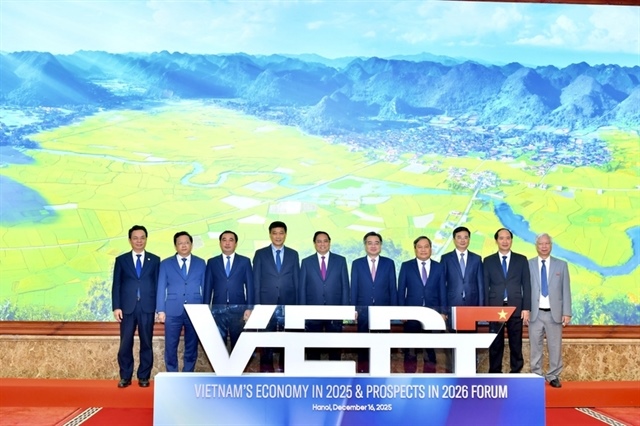Inflation low, but can central bank cut interest rates?
Inflation low, but can central bank cut interest rates?
The Ha Noi Statistics Department reported that consumer prices were up 0.12 per cent in April.

Nine out of the 11 baskets of goods that make up the capital’s consumer price index (CPI), saw their prices rise. Garment, footwear and hats reported the highest increase of 0.44 per cent. Food and foodstuffs followed with a rise of 0.32 per cent.
However, the prices of housing and construction materials slid for a third consecutive month, with the department attributing it to the two cuts in petrol prices by a total of VND280 per litre.
In contrast, HCM City’s CPI inched down 0.04 per cent, according to the city statistics department.
Five out of the 11 baskets of goods in the CPI saw their prices fall in April. The prices of housing and construction materials saw the highest decline of 1.24 per cent.
After a decline of 0.35 per cent in March, food prices again dropped, by 0.52 per cent this time, due to a global price decrease and high supply.
Market observers also expect the country’s CPI to fall in May to below 4 per cent for the year because food and foodstuff account for 42.85 per cent of the index and the price of pork plunged by 40 per cent from last year’s average rate.
Other factors affecting May prices are the falling global oil prices, which have been declining since late April, and the downward trend in the FAO Food Price Index since the beginning of this year.
The trade ministry’s plan to amend electricity prices has yet to be carried out, meaning the prices of many goods will remain steady.
Analysts said the decline in the CPI and some other positive changes in the economy are vital conditions for the State Bank of Viet Nam (SBV) to think of lowering the interest rate.
The Government and the SBV have always attached top priority to cutting interest rates on bank deposits so that lending rates can also be brought down.
Analysts reckon that the central bank is now quite able to reduce the deposit interest ceiling by 0.25-0.5 percentage points while still ensuring positive real interest rates on deposits.
To bring down the deposit interest rates, the central bank can reduce the deposit interest rate ceiling or lower the interest rates on open market operations (OMO).
As of now the interest rate ceiling is being kept at 5.5 per cent for deposits of up to six months, and the OMO rate is 5 per cent.
So the real interest rates – the difference between the nominal deposit interest rates and inflation --could climb to 1-1.5 per cent if the CPI declines in May.
But analysts pointed out that while low inflation is a necessary condition, it is not the sole criterion for the central bank to cut interest rates, and there are other factors too at play.
They include the banking sector’s liquidity, the central bank’s determination to keep exchange rates steady, the trade deficit, and banks’ bad debts, both on and off their balance sheets.
Liquidity at many banks, particularly small ones, is not as plentiful as it was last year.
Credit growth is higher than deposit growth, and lowering deposit interest rates would see money flows shift to real estate and securities, putting even greater pressure on liquidity.
The central bank is making great efforts to keep the dong steady against the US dollar, and any lowering of deposit interest rates at this time would only encourage individuals and banks to turn to the greenback.
Banks’ bad debts were estimated unofficially at 8.86 per cent at the end of last year, or nearly VND500 trillion (US$22.03 billion), and they have to set aside a huge amount of money for risk provisioning.
Foreigners eye takeover of VN food companies
On May 21 the shareholders of the Cau Tre Export Goods Processing Joint Stock Company approved the decision to change the company’s name to the CJ Cau Tre Food Joint Stock Company.
At the end of last year South Korea’s CJ CheiJedang Corporation increased its stake in the company to 47.33 per cent by buying shares from three big shareholders, surpassing SATRA, which owns 45 per cent, as the biggest shareholder.
By March CJ increased its ownership to 51.6 per cent.
Then, last April, the company bought a 20 per cent stake in SATRA in a public auction, taking its holding in Cau Tre Company to 71 per cent .
Recently another Vietnamese company also changed its name to reflect its majority ownership by CJ. In April the Korean company wrapped up a US$13.4 million deal to acquire 64.9 per cent of Minh Dat Food Processing Company and changed its name to Minh Dat CJ.
Minh Dat has the largest share of the country’s meatball and fish ball market.
The change in Cau Tre Company’s name has caused disappointment in some Vietnamese since it has been a famous food brand.
Viet Nam’s food processing industry holds great attraction for investment funds and foreign businesses in this sector thanks to its advantages.
Viet Nam has a market of over 90 million consumers, half of whom are under 30.
Its food consumption is projected to grow at 18.6 per cent annually until 2019, it is blessed with abundant raw materials, while the Government offers investment incentives and there are export advantages arising from the country’s many free trade agreements.
According to Business Monitor International (BMI), the food processing market grows annually at 10-15 per cent.
This year food consumption is expected to be worth $29.5 billion.
But the domestic food processing industry fails to meet the demand, thus creating a huge opportunity for investors entering the sector.
There have been an increasing number of mergers and acquisitions involving foreign food processors in the last three years.
Vissan, for instance, is very attractive to investors. It is one of Viet Nam’s leading companies in the food sector with a huge distribution network of 130,000 sales points at supermarkets, convenience stores and showrooms.
When Vissan announced its IPO plan in March 2016 the number of shares that investors registered to buy was 5.6 times the number on sale. The IPO price finally settled at 4.7 times the starting price.
Anco and Proconso, which are subsidiaries of Masan Group, and CJ CheilJedang, a subsidiary of CJ Group, all hoped to become Vissan’s strategic shareholders. Anco won this contest and paid VND2.13 trillion to acquire 24.9 per cent of Vissan.
The foreign investors in the Vietnamese food sector are mostly from Asia such as Thailand, Taiwan, Malaysia, Korea, and China.
What are the options for local food processors in the face of the strong onslaught by foreign investors?
They can restructure to improve their capabilities and survive on their own. Or, they can sell out to foreign investors as Cau Tre did.
Analysts say these companies are facing an unequal competition due to their limited financial capacity and the lack of professionalism and global relationships.
Due to the poor infrastructure, particularly in logistics, food producers are unable to make long-term strategies, according to the analysts.
If the businesses do not have a thorough understanding of the situation and fail to take effective and appropriate measures, they will be easy prey for hostile foreign suitors, they warn.






















